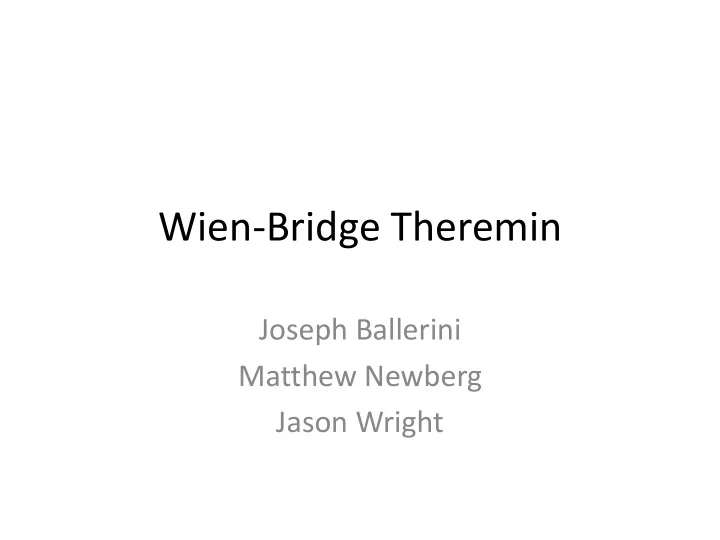

Wien-Bridge Theremin Joseph Ballerini Matthew Newberg Jason Wright
Overview • A theremin is an early electronic musical instrument invented by Russian inventor Léon Theremin in 1928. • The performer moves his or her hands next to antennae to change the volume and/or frequency of the output signal. • Most commercially available theremins cost upwards of $400. • A Wien bridge theremin is easier to manufacture, and does not use inductors
Challenging Specifications • Theremin is a very precise instrument • Important specifications – Effective calibration without affecting oscillation stability – Audible output frequencies – Low signal distortion – Playable with minimal effort (antenna works well)
Top Level Diagram • Wien-bridge oscillators change frequency based on calibration, hand position • Mixer/filter uses heterodyning to output the frequency difference between the oscillators
Top Level Analysis • Oscillation frequency is 1 determined by 𝑔 = 2𝜌𝑆𝐷 component values, which antenna changes • Heterodyning produces output signal with frequency components sin 𝜄 sin 𝜒 = 1 relating to sum and 2 cos 𝜄 − 𝜒 difference of inputs – − 1 higher frequency is 2 cos(𝜄 + 𝜒) filtered out
Wien-Bridge Oscillator • Noise is amplified by the op-amp • Loop gain stabilizes at unity • Key is automatic gain control – originally done by thermistor, 𝑆 𝑔 1 = 2 𝑔 = but many methods 𝑆 𝑚 2𝜌𝑆𝐷
Theremin Version • This example uses a JFET and half-wave detector • Presence of antenna introduces hand- antenna capacitance (1-2 pF) and antenna-ground capacitance (~15 pF) • Can also stabilize with diodes
Mixer/Filter
Top-Level Circuit Audio_out vs. Antenna Capacitance 8000 7000 Output Frequency (Hz) 6000 5000 4000 3000 2000 1000 0 10 11 12 13 14 15 Capacitance (pF)
Performance Summary • Simulation demonstrates stable oscillation across a range of capacitor values • Quality sinusoids were the largest challenge – Mixer needs to be able to handle differences in amplitude – Minor problems in oscillation due to circuit noise requirements – Start-up time
Performance Summary 13 pF 15 pF 7.5 kHz 5.5 kHz
Layout Small transistors Variable Oscillator (550x790) Large capacitors for low- pass filtering Mixer/Filter Local Oscillator (1400x900) (790x550)
Conclusions • Wien bridge oscillators provide stable sinusoids with low distortion, without the need to use an inductor. • Transistor-based heterodyning can produce reasonable, audible output given reasonable antenna capacitances.
Recommend
More recommend